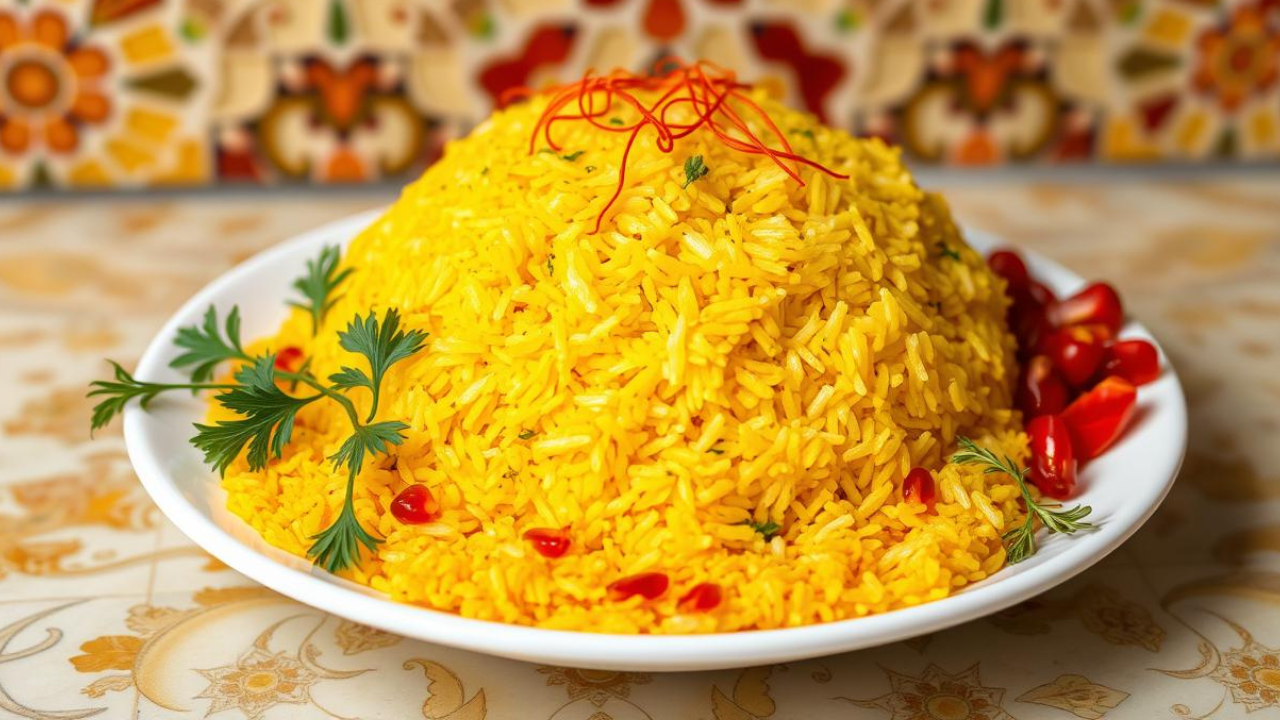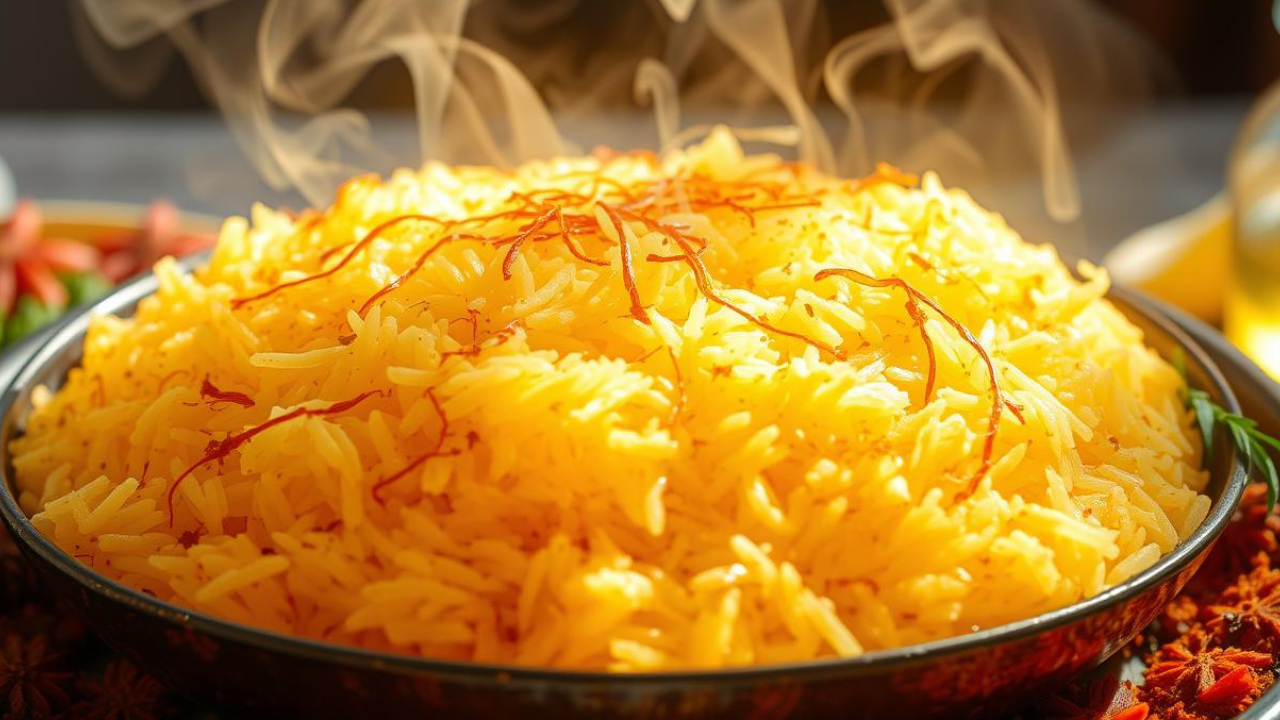Did you know Basmati rice can become a culinary masterpiece? Welcome to Persian saffron rice, loved by Iranians for centuries. You’ll learn how to make perfect Persian saffron rice and Tahdig, its crispy golden crust.

Saffron, the most expensive spice, makes this rice dish special. We’ll explore its history and cultural importance. You’ll learn to cook Persian saffron rice at home.
Table of Contents
ToggleWhat is Persian Saffron Rice (Chelow)?
Persian saffron rice, also known as Chelow, is a favorite dish in Iranian cuisine. It highlights the fragrant and vibrant flavors of saffron and basmati rice. This golden rice, with its crispy crust called Tahdig, is a true culinary treasure.
The Golden Gem of Iranian Cuisine
Saffron rice, or Chelow, is loved in Persian cuisine for its stunning look and taste. The rice’s rich, golden color comes from top-quality Iranian saffron. It’s a visual treat often served with savory stews, kebabs, and other Iranian dishes.
Aromatic Saffron and Basmati Rice Combination
The special taste of Persian saffron rice comes from mixing basmati rice with saffron. The basmati rice’s delicate texture and aroma mix well with saffron’s bold, floral taste. This mix makes Persian cuisine famous around the world.

Persian Saffron Rice Recipe Tahdig Crispy Rice How to Make Persian Saffron Rice
Start a tasty journey through Iranian food with our Persian saffron rice recipe. Learn how to make the tahdig, a golden, crispy rice crust. Follow these steps to make this dish in your kitchen.
The secret to great Persian saffron rice is using top-notch saffron and fluffy basmati rice. By using the rice cooking techniques we share, you can make this dish easily.
- Begin by making the saffron mix. Soak a few strands of saffron in warm water. Let it soak to get the color and flavor.
- Wash the basmati rice well until the water is clear. Then, soak it for 30 minutes to an hour. This makes the rice cook perfectly.
- Boil water in a big pot. Add the soaked rice and simmer for 10 minutes. The rice should be almost cooked but still firm.
- Drain the rice and put it back in the pot. Add the saffron mix. Cover the pot with a clean towel and the lid. This steaming method makes the tahdig crust.
- Cook the rice on low heat for 30-40 minutes. This lets the tahdig crust form at the bottom. Then, flip the rice onto a platter to show off the golden crust.
With this Persian saffron rice recipe, you can enjoy Iranian flavors at home. Impress your guests with the tahdig crust. Serve it with Persian stews or kebabs for a real Iranian meal.

Essential Ingredients for Authentic Saffron Rice
Making the perfect saffron rice cooking dish is more than just using good ingredients. It’s about knowing how each part works together. The key is the golden spice, saffron, which gives it a special flavor and color.
High-Quality Saffron: The Key to Flavor
The secret to Persian saffron rice’s unique taste is the quality of the saffron. It comes from the delicate stigmas of the Crocus sativus flower. This makes it very valuable, known as the “red gold” of middle eastern ingredients.
Its strong smell and soft, earthy taste are hard to find elsewhere. But, not all saffron is the same.
To make your saffron rice as real as it can be, find the best saffron. Look for deep red, plump threads. They should smell strong when you crush them. Stay away from pale, dry, or brittle saffron. It won’t have the flavor needed for this dish.
“The quality of the saffron is the single most important factor in creating a truly authentic Persian saffron rice dish.”
By choosing high-quality saffron, you’ll make this saffron rice cooking dish amazing. It will take your taste buds to the heart of Iranian cooking.

Step-by-Step Guide to Cooking Persian Saffron Rice
Learning to make Persian saffron rice, or Chelow, is like mastering a fine art. This guide will help you cook aromatic basmati rice dishes. You’ll learn the rice cooking techniques that make this Iranian dish special.
Preparing the Saffron Mixture
To start, make the saffron base that gives your rice its golden color and smell. First, warm a few strands of saffron in a small pan over low heat. When it smells good, crush it with a mortar and pestle. Then, soak it in hot water for at least 15 minutes.
Steaming and Layering the Rice
- Wash your basmati rice well under cool water until the water is clear. This is key for the right texture.
- Put a lot of salted water in a big pot and boil it. Add the rinsed rice, lower the heat, and simmer for 10-12 minutes. The rice should be tender but still a bit firm.
- Drain the rice and put it back in the pot. Pour the saffron liquid over the rice and mix it gently. This will make the rice look beautiful.
- To make the tahdig (crispy rice crust), spread a thin layer of rice at the bottom of the pot. Cover the pot with a clean towel and close the lid tightly.
- Steam the rice over low heat for 30-40 minutes more. This will make the tahdig crispy and the rice fluffy and fragrant.

Follow these steps to make a stunning Persian saffron rice dish. It will amaze your taste buds and take you to the heart of Iranian cooking.
The Art of Tahdig: Crispy Rice Crust
In Persian cuisine, the tahdig is a must. It’s a crispy, golden crust at the pot’s bottom. It’s all about mastering the art of tahdig in Iranian food to make your saffron rice amazing.
To get the perfect tahdig, you need to cook the rice just right. It should be tender but still separate. Also, make sure the pot is ready with the right amount of oil or butter.
- Use a heavy-bottomed pot or pan with a tight-fitting lid for even heat distribution.
- Apply a thin layer of oil or melted butter to the bottom of the pot, just enough to coat the surface.
- Gently layer the cooked rice, taking care not to compact it too firmly.
- Cover the pot and cook on low heat for 30-40 minutes, allowing the tahdig to slowly form and crisp up.
Getting the perfect tahdig takes patience and timing. With practice, you’ll make a crispy, golden crust. It will wow your guests and bring them to Persian cuisine.
“The tahdig is the crowning glory of Persian saffron rice, a crispy, golden-brown crust that is the ultimate expression of the chef’s skill.”
Serving Suggestions and Accompaniments
In Iranian cuisine, Persian saffron rice is a big hit. It’s even better with Persian stews and kebabs. Find out what goes well with Middle Eastern rice dishes to make them even better.
Traditional Persian Stews and Kebabs
Ghormeh sabzi is a top choice with Persian saffron rice. It’s a tasty herb stew that goes well with the rice. Fesenjan is another favorite, with its mix of walnuts and pomegranate.
Grilled Persian kebabs like jujeh, koobideh, and barg are great too. They add smoky flavors that match the rice’s saffron taste.
“Pairing Persian saffron rice with traditional stews and kebabs is a time-honored tradition that celebrates the depth and diversity of Iranian cuisine.”
For a full meal, add fresh herbs, a crisp salad, and creamy yogurt. This mix lets the rice’s flavor stand out while adding freshness.
Variations and Regional Twists
The classic Persian saffron rice, known as chelow, is loved in Iranian cuisine. But, there are many regional twists and variations. One such dish is Shirin Polo, a sweet saffron rice with dried fruits.
Shirin Polo: Sweet Saffron Rice with Dried Fruits
Shirin Polo is a traditional Iranian dish. It mixes saffron-infused basmati rice with dried fruits. This mix creates a sweet and savory taste.
It’s a favorite at special occasions. The saffron, dried fruits, and spices make it a unique dish.
There are many other Iranian dishes to try. Like Sabzi Polo with fresh herbs and Adas Polo with lentils and onions. Persian rice dishes offer a wide range of flavors.
| Dish | Key Ingredients | Regional Origin |
|---|---|---|
| Shirin Polo | Saffron rice, dried fruits, orange zest, cinnamon, rose water | Iran |
| Sabzi Polo | Saffron rice, fresh herbs (parsley, dill, cilantro, fenugreek) | Northern Iran |
| Adas Polo | Saffron rice, lentils, caramelized onions | Southern Iran |
Exploring Persian cuisine is a fun journey. You’ll discover many rice dishes and their unique flavors.
Cultural Significance and Traditions
Persian saffron rice, or Chelow, is very important in Iranian culture. It has been a key part of Persian food for many years. It’s served at big celebrations and everyday meals, showing the Iranian people’s rich culture.
In Iran, saffron rice is a big deal at weddings, New Year’s, and family get-togethers. Making and serving this dish is full of tradition. The crispy tahdig at the bottom is especially loved and shows the cook’s skill.
Saffron rice is also a big part of daily life in Iran. It goes with stews and grilled meats, like Khoresh and Kebab. The mix of saffron, rice, and spices makes a unique taste that Iranians love.
FAQ
What is the difference between Persian saffron rice and regular rice dishes?
Persian saffron rice uses top-quality saffron. This makes it golden and flavorful. It also has a crispy crust called Tahdig, which is special in Iranian food.
What is the significance of Tahdig in Persian saffron rice?
Tahdig is the crispy golden crust at the bottom. It’s the best part of Persian saffron rice. People love to get the crispy bits.
What are the key ingredients for making authentic Persian saffron rice?
You need good saffron, basmati rice, and some extras like yogurt and salt. How you prepare these is key for the right taste and texture.
How do I ensure the rice is cooked properly and the Tahdig is perfectly crispy?
Soak the rice, steam it, and layer it right. The right cookware and heat control are also important. This helps make the Tahdig crispy.
What are some traditional Persian dishes that pair well with saffron rice?
Saffron rice goes great with Iranian stews like Gheimeh or Fesenjan. It also pairs well with grilled meats and kebabs. These dishes match the rice’s flavor well.
Are there any regional or unique variations of Persian saffron rice?
Yes, there are many variations. Shirin Polo adds dried fruits and nuts for a sweet twist. Some recipes also use spices or herbs for different tastes.

Meet Misha Mehboob, a passionate food enthusiast and computer science student from Sargodha University. Misha’s culinary journey is fueled by her love for exploring new flavors and experimenting in the kitchen.
At CrispyEatHub, Misha shares her creative recipes and practical cooking tips to inspire fellow food lovers on their culinary adventures. From quick weeknight dinners to indulgent desserts, there’s something delicious for every palate.
Join Misha as she combines her love for food and technology to create mouthwatering dishes that delight the senses and bring people together. Let CrispyEatHub be your go-to resource for culinary inspiration and delicious recipes that make every meal memorable.

